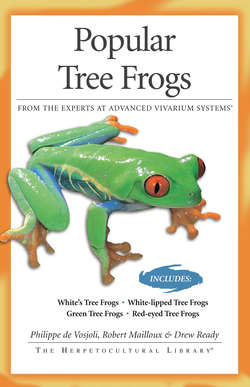Читать книгу Popular Tree Frogs - Robert Mailloux - Страница 5
На сайте Литреса книга снята с продажи.
ОглавлениеCHAPTER 1
GENERAL INFORMATION AND SELECTION
What are Tree Frogs?
Tree frog is the popular term for arboreal and semiarboreal, nocturnal frogs that have toe pads at the ends of their digits. The common name “tree frog”is usually reserved for members of the family Hylidae, but the popular herpetocultural definition also includes the glass frogs (family Centronelidae), reed frogs (family Hyperolidae), and flying frogs (family Rhacophoridae).
Selecting Tree Frogs
If you are new to keeping tree frogs, your best bet is to begin with a species that has simple, clear-cut care requirements; possibilities include White’s tree frogs (Litoria caerulea), white-lipped tree frogs (L. infrafrenata), green tree frogs (Hyla cinerea), and Cuban tree frogs (Osteopiius septentrionalis). Other tree frogs require some experience, particularly if they are wild-caught imports, but, if you follow the instructions in this book, you also should have success with moderately difficult-to-keep species, such as the ever-popular red-eyed tree frogs.
As a rule, species that require cool, temperate conditions, or hail from a cloud forest or tropical rainforest tend to be more difficult to keep than the more adaptable temperate and subtropical species. This is usually because cloud-forest and rainforest species have specific habitat requirements—such as a particular landscape, temperate range, relative humidity range, or air flow—that need to be duplicated if the frogs are to survive for a long time. However, researching the habitat and niche of particular tree frogs, acquiring experience at establishing frogs, and setting up the right type of vivaria will allow you to successfully keep and breed these more difficult species.
A rare “blue” axanthic green tree frog.
This book focuses on the care of easy-to-keep and readily available species, but also includes information on gliding tree frogs, an appealing species that has more complex care requirements.
The first step to keeping tree frogs successfully is to select the species that you can comfortably accommodate. The second step is to select potentially healthy animals (see below).
Captive-Bred Versus Wild-Caught Specimens
White’s tree frogs are captive-bred in large numbers in the United States and are generally easy to rear to adulthood. Other captive-bred species are available less frequently and, due to the small size and special requirements of their young, are often more difficult to rear. Wild-caught adults of the popular species mentioned in this book (with the exception of gliding tree frogs) are relatively easy to establish in captivity and are probably as good a choice as captive-bred frogs. However, keeping more difficult species, whether wild-caught or captive-bred, will prove challenging, and very possibly disappointing, to inexperienced herpetoculturists.
Selecting Healthy Tree Frogs
To have success with tree frogs, you must select healthy specimens. The following guidelines will help you make the right choice:
1. Select species that you can accommodate. Research the needs and vivarium design requirements of whatever species you plan to purchase, and make sure you have the time, money, and space to meet their requirements. Your frogs will not survive unless you provide them with the proper captive conditions.
2. Observe the animals you plan to purchase. Generally, tree frogs that perch on the glass sides or the landscape structures of a vivarium prove healthier than those that remain on the ground. However, this is only a guideline, not an absolute rule. Occasionally, if a store owner or seller keeps their frogs in the wrong kind of vivarium, stressed tree frogs may seek terrestrial shelters or specimens may move to the ground to reduce dehydration or find cooler temperatures.
3. Carefully inspect the animal. It should not have sores, lumps, swollen legs, or clouded eyes. Its body should appear rounded, and the outlines of its hip bones, backbone, and skull should not be prominent.
A healthy White’s tree frog has very smooth rounded contours.
4. When held in your hand, the frog should demonstrate definite signs of vigor. A frog that seems limp or weak is usually very ill. Once you have a frog in hand, reinspect its body, including its ventral area (underside), for sores or redness. Avoid animals that have these symptoms.
5. If the frogs are kept on paper substrate, look for signs of feces. Watery, runny feces usually indicate illness, and bloody feces are a definite sign of physical problems.
If the frog you select has met these criteria, there is a good chance that it is relatively healthy and will acclimate to captivity, given the proper conditions.
Aerosols and Miticides
Aerosol sprays, such as hair spray, perfume deodorants, and disinfectants, can kill tree frogs. The frogs absorb the aerosols through their skin and, thereafter, often suffer painful deaths. Do not keep frogs in areas (e.g., bathrooms or kitchens) where aerosols are used. High concentrations of or long-term exposure to No Pest strips, used for killing mites, will also kill frogs.
